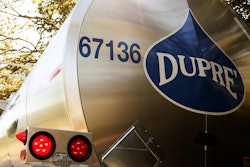The appearance of the pumps may not change but the diesel fuel they dispense will soon undergo a seasonal shift.
Pilot Flying J, Love’s and TravelCenters of America each use cold flow, broad spectrum additives to treat diesel fuel at stores in cold weather locations for the duration of the winter season.
“With the exception of our cold weather stores, we blend additive only when the weather warrants,” said PFJ Director of Supply Mid-continent Bryan Stickley.
ET Products Vice President of Sales Frank Bradley said the product also offers a deicing element to help minimize fuel filter freeze ups.
Even with additives blended in before the fuel ever leaves the nozzle, off-the-shelf products remain popular but more additive doesn’t necessarily equal better protection.
“Data typically shows that anything more than a triple treatment of cold flow into diesel fuel will have greatly diminished return on improving the cold filter plugging point of diesel,” Stickley said. “Most improvement will be made in the first and second treatments.”
Steve Sikorsky, vice president of strategic accounts for Howes, noted because Howes products don’t contain alcohols or solvents, overtreatment is not harmful to the diesel fuel system.
“A high quality fuel additive should be added to the tank on every fill-up,” he said.
Love’s Vice President of Transportation Brent Bergevin said additives with a specific target – like an anti-gel or cetane boost – and fuel conditioners are fine to pour in as long as drivers are choosing one that meets their specific needs.
“Keep in mind that some additives are designed to help thaw out frozen fuel systems and others are designed to prevent the fuel from freezing and gelling in the first place,” added TravelCenters of America Director of Technical Service Homer Hogg. “Is that fuel treated for the climate you are heading towards? Has it been treated properly for cold weather? If not, you’ll want to treat the fuel in your tanks in order to avoid the paraffin wax in the fuel from clouding up and gelling. This will cause the fuel to clog filters and can eventually stop the fuel from flowing altogether.”
Since many additives disperse water from the fuel, Sikorsky said is necessary to check the water separator from time-to-time and drain water from the bowl. Bergevin recommend drivers drain filters and fuel tanks daily to get rid of condensation.
Adding too much of any additive is not advised and Hogg said the key to avoiding over conditioning the fuel is to first understand the fuel that you’re pumping into the tanks.
“If the fuel you’re pumping into your tanks has not been properly treated, then you should consider treating the fuel directly in the tanks on your truck, [but] be certain to use the correct additive at the right time,” he said.
Fuel additives, Hogg added, can help with lubricity but overdoing it can negatively impact fuel efficiency and could void engine warranties. Hogg suggested checking with the engine manufacturer before treating fuel to help avoid any engine damage and/or voiding warranties.
However, as long as the product is used as stated on its container, Hogg said there’s little risk in causing exhaust and DPF problems. Sikorsky recommended fleets and drivers use products that are “DPF friendly, like all of Howes products.”
“The trick is to be sure you use the correct amount of treatment. Some additive containers include measuring scales on the bottle, which can be helpful,” Hogg said. “It’s also a good practice to keep a measuring container in your truck to ensure you are properly mixing the fuel in your tanks with the ratio requirements noted on the additive’s label.”
Winter diesel is often knocked for causing a reduction in miles per gallon, but Stickley said there is no measurable effect on MPGs with diesel treated with cold flow improver, adding cold flow improvers do not affect the cetane of diesel.
“While all trucks and engines are different, we’ve seen trucks get slightly lower MPGs during winter months,” Bergevin said. “This could be from extreme cold weather and longer idling times that professional drivers endure.”
“Friction naturally increases in your engine, transmission and rear axles in cold climates. Cold air is dense, therefore making it more difficult for the vehicle to push through,” Hogg added. “Tire pressure will decrease, which can increase rolling resistance.”











